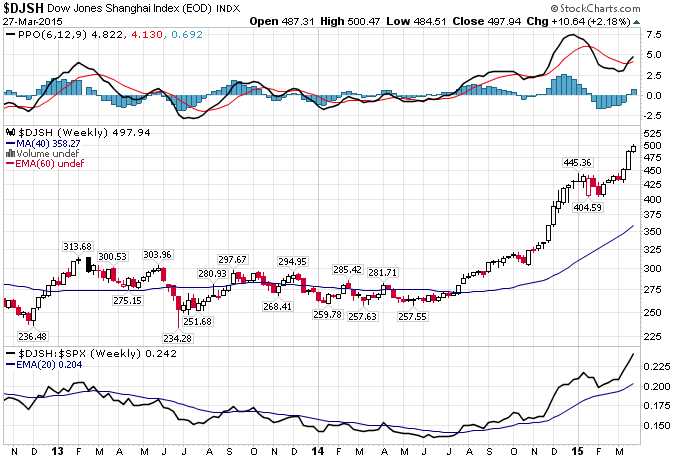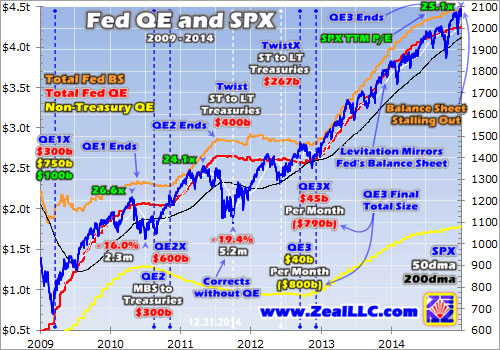 MORE FREE MONEY!!!
MORE FREE MONEY!!!
This time it's China's turn (again) as PBOC Governor Zhou Xiaochuan said "the authorities need to be vigilant for deflationary risks in the economy and have injected liquidity into the financial system." That was all it took to add 2.5% to the Shanghai Composite, which is now up 100% since last April. At the same time, Finance Minister Lou Jiwei said China will likely expand the recently announced local government debt relief program.
Adding to the optimism, Chinese officials fleshed out some details for plans to better connect the economy with the rest of Asia, Africa, the Middle East and Europe with more roads, railways, ports and other related projects. Meanwhile, flows into Hong Kong via the Stock Connect trading link were approaching a record high after Chinese mutual funds gained approval from the China Securities Regulatory Commission to start making use of the new channel, which has seen disappointing volumes so far.
The only thing not on China's list is building more empty cities, as they are still bailing out builders and Governments from that disaster. Still, China is on pace to have 82 empty airports by the end of 2015, which will bring them to 230 airports, most of which are extremely underutilized.
Academically, this is a very interesting excercise as we'll get to see how long Fundamental laws of Economics can be ignored before a country collapses. China is doing through uneccessary infrastructure and Japan is doing it through immense amounts of debt that they use to paper over their own stumbling economy and aging work-force. The airport math for China is simple, the per capita GDP in China is $6,807 vs $41,787 in the UK and $53,042 in the US yet airfare is roughly the same in all countries. In what possible way can the Chinese people afford to use these airports?
Supply with no demand. That's why China has dozens of entire cities with no people in them. They've been "building" their economy this way for years and that has created false demand for commodities (as they were using them to build things no one wanted or needed) and now they have a surplus that will take the better part of a decade to work off.
 Now, you may wonder that, if this is so obvious, why does the Chinese market keep going higher. That was a mystery to all of us until this weekend, when Bloomberg discovered who is investing in this late stage of the rally – it's the poor and uneducated that are rushing into the market, wanting to take part in those 100% annual returns they've been hearing about.
Now, you may wonder that, if this is so obvious, why does the Chinese market keep going higher. That was a mystery to all of us until this weekend, when Bloomberg discovered who is investing in this late stage of the rally – it's the poor and uneducated that are rushing into the market, wanting to take part in those 100% annual returns they've been hearing about.
Notice "Graduate and Above" have completely disappeared in the New Investor category, replaced by 5.8% "Not Literate" but still able to pull a few Yuan from under the mattress to buy a company with a p/e of 400 that has 3 employees but "a lot of buzz." Does this remind you of 1999? It does to us – that's why we cashed out most of our longs last Tuesday (see our March Portfolio Review) and we're taking an early Easter break while we wait to see if Q1 earnings can convince us to jump back in.
 Certainly a move up to test the Strong Bounce lines (see Friday for levels) is not going to impress us when it's driven by more stimulus talk. Monday's are meaningless at the best of times and this one is being made more so by more Central Banksters trying to talk up the markets (not to mention end of month window-dressing).
Certainly a move up to test the Strong Bounce lines (see Friday for levels) is not going to impress us when it's driven by more stimulus talk. Monday's are meaningless at the best of times and this one is being made more so by more Central Banksters trying to talk up the markets (not to mention end of month window-dressing).
WHAT ARE THEY SO AFRAID OF that they can't allow even a 2.5% pullback to pass without rushing back in to drive the market higher?
What remains to be seen. Perhaps there are no monsters in the closet after all, perhaps Big Daddy Central Banksters can protect us forever from all the financial harms in the World, as they are currently promising. If so, we're not going to miss much by sitting out the next couple of weeks and gathering data from the sidelines. If it's a real rally, our materials stocks will begin to gain some ground as well.
And speaking of Central Banksters – I can't let today pass without pointing you to Ben Bernanke's blog, where he tells us to stop worrying and love the low rates.
A similarly confused criticism often heard is that the Fed is somehow distorting financial markets and investment decisions by keeping interest rates “artificially low.” Contrary to what sometimes seems to be alleged, the Fed cannot somehow withdraw and leave interest rates to be determined by “the markets.” The Fed’s actions determine the money supply and thus short-term interest rates; it has no choice but to set the short-term interest rate somewhere. So where should that be?
Where indeed?



